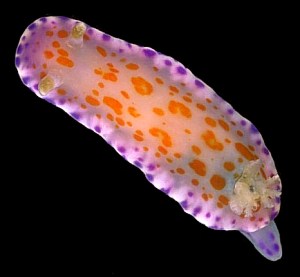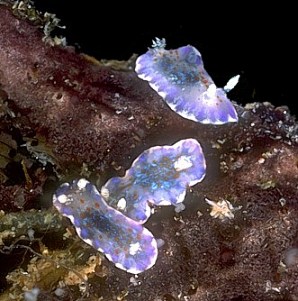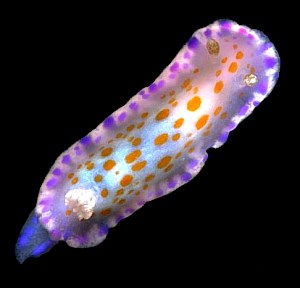
Chromodoris ambiguus
Rudman, 1987
Order: NUDIBRANCHIA
Suborder: DORIDINA
Family: Chromodorididae
DISTRIBUTION
Known only from southern Australia, (Victoria, Tasmania, South Australia).
PHOTO
UPPER: Horseshoe Reef, Devonport, Tasmania, 12m, November 1984, 21mm long.
LOWER LEFT: Juveniles on sponge, Chelonaplysilla violacea Eyre Peninsula, South Australia, 4-5mm long, February 1985.
LOWER RIGHT: Port Sorell, Northern Tasmania, February 1984, 21mm long.
PHOTOS: Bill Rudman.
Similarly coloured species
Chromodoris ambiguus is very similar in colour to Digidentis perplexa especially in specimens of D. perplexa where the submarginal purple line is broken into a series of spots. However C. ambiguus is much more ovate with a prominent mantle overlap and the background colour is a translucent white whereas in D. perplexa the body is elongate, the mantle overlap along the sides relatively narrow, and the mantle colours, including the white background colour, bright and opaque. In C. ambiguus the gills are translucent with white speckling and the rhinophore clubs are a translucent straw colour with white edging to the lamellae while in D. perplexa both gills and rhinophores are white with bright orange markings. The two species can be clearly separated by the differences in their internal anatomy.
Another species, Chromodoris alternata, is also very similar in colour, the main difference being that it has a large orange-brown patch covering the central part of the mantle whereas in C. ambiguus this region has a large number of small irregularly shaped orange to orange-brown spots.
At present this species is known from Tasmania, South Australia and Victoria in south-eastern Australia, the same region in which the similarly coloured D. perplexa and C. alternata occur.
There are many red and orange-spotted species of chromodorid in New South Wales and southeastern Australia. I have discussed this example of mimicry on a separate page.
Reference:
• Rudman,W.B.,(1987). The Chromodorididae (Opisthobranchia : Mollusca) of the Indo-West Pacific: Chromodoris epicuria, C. aureopurpurea, C. annulata, C. coi and Risbecia tryoni colour groups. Zoological Journal of the Linnean Society 90: 305-407.


Rudman, W.B., 1999 (June 1) Chromodoris ambiguus Rudman, 1987. [In] Sea Slug Forum. Australian Museum, Sydney. Available from http://www.seaslugforum.net/factsheet/chroambi
